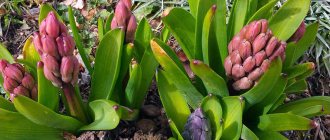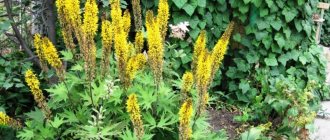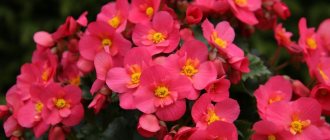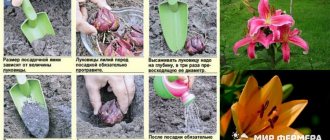A large number of flower growers in different parts of our planet have long appreciated the graceful beauty and uniqueness of the plant with the melodious name “verbena”. It is ideal for growing both in open and closed ground, so we can see the luxurious inflorescences of a delicate flower not only in personal plots and flower beds, but also on the balconies of city streets. The photo of verbena shows the period of its flowering, and we will tell you in detail how to plant the plant correctly and provide proper care in this article.
Canadian verbena Homestead Red is a low-growing variety used as an ampel and ground cover.
Verbena: what is it?
Verbena belongs to the verbena family and has about 250 varieties of seasonal and perennial plants. It grows well in any climate zone; in tropical conditions it blooms profusely almost all year round and looks like a small shrub. That is, at its core, verbena is perennial. But in our country it is most often grown as a herbaceous annual.
Plant height varies from 20-40 cm (hybrid and Canadian verbena) to 150-200 cm (Bonar verbena, hard, lemon). The width of even low-growing species often reaches 70–80 cm. Depending on the type of flower, the stems can be erect (bush varieties) or creeping (ampels).
Bonar or Buenos Aires verbena (Verbena bonariensis) is a tall plant that blooms with purple fragrant flowers.
Hybrid verbena (Verbena hybrida) is the most common species, characterized by a variety of varieties. Pictured is the Vegas Fluor Pink variety
The jagged leaves of verbena have a pleasant bright green hue. On each individual stem of the plant, 40–50 miniature carnation-like flowers are formed, which recreate a beautiful “cap”.
The color palette of inflorescences is very diverse. White, pink, peach, red, purple, blue, blue - these are not all the tones that verbena can boast of. Moreover, the flowers can be either monochromatic or combine several colors at once. For example, the hybrid verbena variety Lanai Twister Red has inflorescences with red and pink petals. And the Tuscany Burgundy Eye variety has dark burgundy flowers with a white eye in the center.
Hybrid verbena Lanai Twister Red
Popular varieties with red and scarlet flowering
The most popular varieties have red flowers.
Tiara red impr (tiara red impr, or red imperial crown)
Bright red inflorescences look advantageous against the background of dark green foliage.
The bush is compact, unpretentious, and can withstand short frosts.
Estrella voodoo star
Flowers with two-tone colors - white and bright red.
Obsession Burgundy
Or an obsessive cascade. Refers to new varieties of verbena with high resistance to common diseases (for example, powdery mildew) and decorative qualities.
Verbena character
Verbena is quite unpretentious. It is resistant to heat and drought. It is not afraid of slight autumn and spring frosts (down to -3°C), so it can delight with its flowering from spring to October (even longer in the southern regions).
Also, verbena does not have any special requirements for soil quality. The only condition: it must allow moisture to pass through well and prevent stagnation of water and subsequent waterlogging. Clayey, heavy soil is not suitable; it slows down root growth and causes root rot. In southern regions, perennial varieties of verbena often disappear when planted in soil that becomes soggy after heavy winter snow or spring rain. Good drainage can compensate for this problem.
Another advantage of verbena is its long flowering, which does not subside in the summer heat. And a very wide range of colors.
Conditions of detention
Ampelous verbena loves light, grows poorly in the shade, and flowering slows down. Can grow in full sun, on the south side of the house.
Air, temperature
Ampelous verbena is grown every year as an annual ; this variety does not tolerate severe frosts. Tolerates light frosts down to -3 – 4°C. Ampelous verbena is very thermophilic; damp, cold climates are poorly tolerated by the flower, and it begins to hurt.
The optimal temperature for growth and development of ampelous verbena is 18 – 22°C.
The substrate for this variety should be moderately moist, loose and not contain large doses of mineral salts. The soil should not contain large amounts of nitrogen, which promotes the growth of shoots - stems and will inhibit the development of buds. The substrate should be regularly moistened; dry soil provokes the appearance of flower diseases.
Additional loosening of the substrate is required before the bush grows . Also, to maintain a moist substrate, it is advisable to mulch the soil surface with rotted leaves.
Soil composition for ampelous verbena:
- The drainage layer is a mixture of broken bricks, expanded clay, and crushed stone.
- Garden soil – 2 hours.
- Sand – 1 hour.
Gardeners believe that for ampelous verbena, fertile loam can be used as the basis for the soil .
The presence of drainage and holes in the pot for water outflow prevents the root from getting excessively wet and rotting.
Ampelous verbena prefers regular but moderate watering. In summer, it is recommended to water every other day in the morning. Young seedlings are watered every day in small doses.
In autumn, watering should be reduced. Water the flower as needed when the top layer of soil in the pots dries out .
Ampel verbena is fertilized every 2 weeks with complex mineral fertilizers.
The ampelous verbena variety requires more feeding than other types of verbena.
It is necessary to strictly adhere to the dosage of fertilizing ; with excessive fertilization, green mass develops, but the formation of buds is delayed. In early spring, to grow leaves, the flower should be fed by watering with the addition of nitrogen fertilizers.
To form flower buds, in early May, you should use fertilizers:
For better absorption and uniform distribution, fertilizers are usually combined with watering.
Planting in garden flower beds and pots
To plant verbena in open ground, it is best to choose a well-lit place, since the plant is very heat-loving and grows well even in dry conditions.
The soil should be loose, light, it should first be enriched with humus and fertilized with a special compound (for example, humus). Ideal PH 5.8-6.2.
Be sure to avoid frost. Despite the cold resistance of adult plants, seedlings can slow down in growth when exposed to sub-zero temperatures. Verbena is usually transplanted to a permanent location in mid/late May.
Low-growing verbenas are planted at a distance of 20 cm from each other, ampelous and groundcover - at a distance of 25-30 cm. Tall species will require even more space; they are planted at intervals of 25-35 cm.
Verbena Lanai Blush White in open ground
If planting is done in indoor pots, be sure to provide drainage. To do this, place a layer of pebbles or expanded clay on the bottom of the container, only then fill the form with soil mixture.
The same verbena - Lanai Blush White - but in hanging boxes
Transplantation is carried out using the transshipment method. This means that the sprout is removed from the container along with a lump of earth. This way, the plant’s root system will remain intact, and it will quickly take root in its new location.
The finished pots are placed in the sunniest place, where it is possible to create a constant flow of fresh air for the plant.
What kind of plant is this?
Verbena ampelous is an annual herbaceous flower of the Verbena family . Its homeland is the Mediterranean countries, Europe, North and South America. Natural varieties are also found in the Far East and Central Asia. There are about 250 varieties. The ampelous verbena variety was bred in the second half of the 20th century.
Ampelous verbena does not have a dormant state. Typically the flowering period begins at the end of May. Flowering is abundant and continues until early October. The stems branch, hang down by 50–60 cm. The width of the crown of an adult flower is 50 cm. The leaves are simple, dense in structure, covered with hairs, openwork.
The flowers have 5 petals, the flowers are small, the sepals are 1 - 1.5 cm in diameter. The color range is varied - hybrid varieties have lavender, blue, purple, all shades of red, pink, lilac. You can learn about hybrid verbena here.
The inflorescences are large, voluminous, and contain up to 30–35 flowers. This variety is usually planted in hanging baskets and plant pots. Ampelous verbena grows quickly, so annual replanting is required . The root is compact. The fruit has the shape of a small hazelnut, light brown or greenish marsh color. When ripe, the fruit splits into 4 parts.
Look at the photo of verbena from the ampelous type:
Basic nuances of care
With correct planting of verbena and high-quality care, the plant will bloom profusely from the end of May until the end of October inclusive; the inflorescences are distinguished by their attractiveness; you can appreciate their tenderness and beauty from numerous photos of flowers.
Regardless of the growing conditions for verbena (outdoor/indoor), you need to provide the plant with ideal conditions:
- the temperature should vary in the range of 22–28 degrees; if it increases significantly, experienced gardeners advise covering the verbena with a light cloth or temporarily moving it to the shade;
- the same applies to lighting; scorching sun rays can lead to rapid drying of the soil and leaves;
- complex fertilizer is applied once every 2–3 weeks throughout the entire flowering period;
- water the verbena after the top layer of soil has dried; it is not recommended to spray the leaves and top;
- after watering, loosen the soil - this improves root aeration;
- to prolong the flowering period, faded inflorescences are torn off;
- If necessary, you need to trim overgrown shoots, this will help to form an attractive flower head.
Verbena in a composition with petunia in a hanging pot
Collecting seeds
Caring for and planting perennial phlox
The easiest way to grow verbena is through seeds. You can collect them as the plant blooms. It takes 30 days for them to ripen, then they quickly fall off.
Important! The collected seed should be stored in a dry, dark place.
The seeds are collected as dry brown fruits, which resemble nuts, form. It is better to carefully cut off a branch of the plant and collect the seeds at home.
The seeds are brown in color and have an elongated narrow shape.
There is no need to rush to plant them. It is better to sow them in April or early May, since at this time there is a sufficient amount of sun. Seedlings will not grow quickly in dark rooms. At home, you can plant verbena in March, since during this time it will get stronger and can be taken out to the balcony.
Diseases and pests of verbena
The diseases to which verbena is most susceptible are:
- powdery mildew - a white powdery coating forms on the surface of the leaves and flowers, the lower leaves turn yellow and sag, gradually the entire bush turns yellow and dies without treatment;
- gray rot - spots appear on the leaves, buds and flowers rot, infected tissues become covered with a gray dusty coating;
- root rot - the plant turns yellow and withers, the roots become dark brown.
Powdery mildew on verbena
All these diseases are fungal in origin and occur due to improper watering or infection. Fungicides are used for treatment.
Of the pests that attack verbena:
- Thrips - pierce and suck out plant cells, as a result of which silvery-gray “movements” and spots appear on the surface of the leaves. When the level of infection is high, the leaves dry out.
- Spider mite - pierces leaf tissue, leaving small yellow dots on it. Lives and feeds on the underside of leaves. When the population is high, it forms a web.
- Aphids - feed on plant sap, piercing the tissue. This slows growth and can cause leaf death.
To destroy aphids and thrips, insecticides are used; for spider mites, an acaricide is needed.
Important!
Healthy, vigorous plants are less susceptible to pests. Therefore, when growing verbena, the main thing is to pay attention to proper agricultural technology.
Reproduction
Ampel verbena is propagated by cuttings. This method is usually used for hybrids that do not produce seeds. The verbena flower is brought into a cool room for wintering . The air temperature should be 5 – 10°C. Cuttings of ampelous verbena are carried out in February - early March.
Soil composition for cuttings - seedlings:
Algorithm:
The finished substrate is heated and poured into containers or boxes.- Cut cuttings of the upper shoots.
- Each cutting must have at least 4 leaves.
- The lower leaves are cut from the cuttings.
- The cuttings are pre-soaked for a day in root for better rooting.
- Planting stems are planted, deepening them by 1 cm.
- For a greenhouse effect, seedlings are covered with film or glass.
- Regular ventilation and watering are required.
- After a month, roots will form.
Next you can watch a video about the propagation of ampelous verbena:
How to Preserve Verbena in Winter
To ensure proper wintering, garden verbena is cut to 1/3 at the end of autumn and then dug up so that the roots of the plant are completely covered with soil. Such cuttings are best preserved in dark cellars.
House flowers are moved to a warmer, brighter place before the first frost arrives. The temperature in the room should not exceed 15°C, otherwise an active growing season will begin.
The stems are shortened by half, and the resulting inflorescences are periodically removed until spring. At the end of February, the remaining trunk is shortened as much as possible and transplanted into a new pot, with a complete replacement of the soil. This way you can preserve last year’s verbena, which will still bloom in the new season (that is, make it a perennial even in our climate). However, most often it is used as a mother plant for cutting cuttings and growing new young bushes.
We invite you to watch a video about cuttings from an overwintered verbena mother plant:
If you strictly follow all these recommendations, then next season the verbena will grow more actively and new flowers will quickly grow on it!
Features of the view
- Verbena is distinguished by its healing properties. Its flowers are used to treat abscesses, scrofula, and also to activate brain activity. The flower is widely used in cosmetology; verbena extract is included in creams and face masks. Read about the beneficial properties and contraindications to the use of verbena herb here.
- In design it is used as a decorative home flower. Valued by flower growers for its colorful blooms and beautiful, curly green leaves.
- The variety is distinguished by its unpretentiousness and long-lasting bright flowering. Serves as an excellent honey plant, and also provides nutritional material for butterflies and caterpillars.
Read also: Purslane: how to remove the weed











